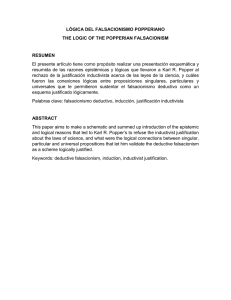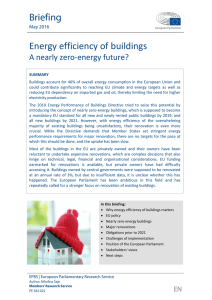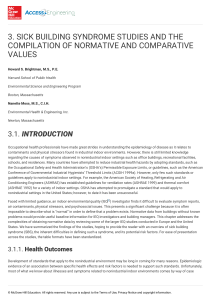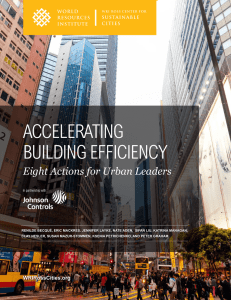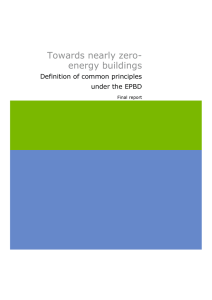ES ES DOCUMENTO DE TRABAJO
Anuncio
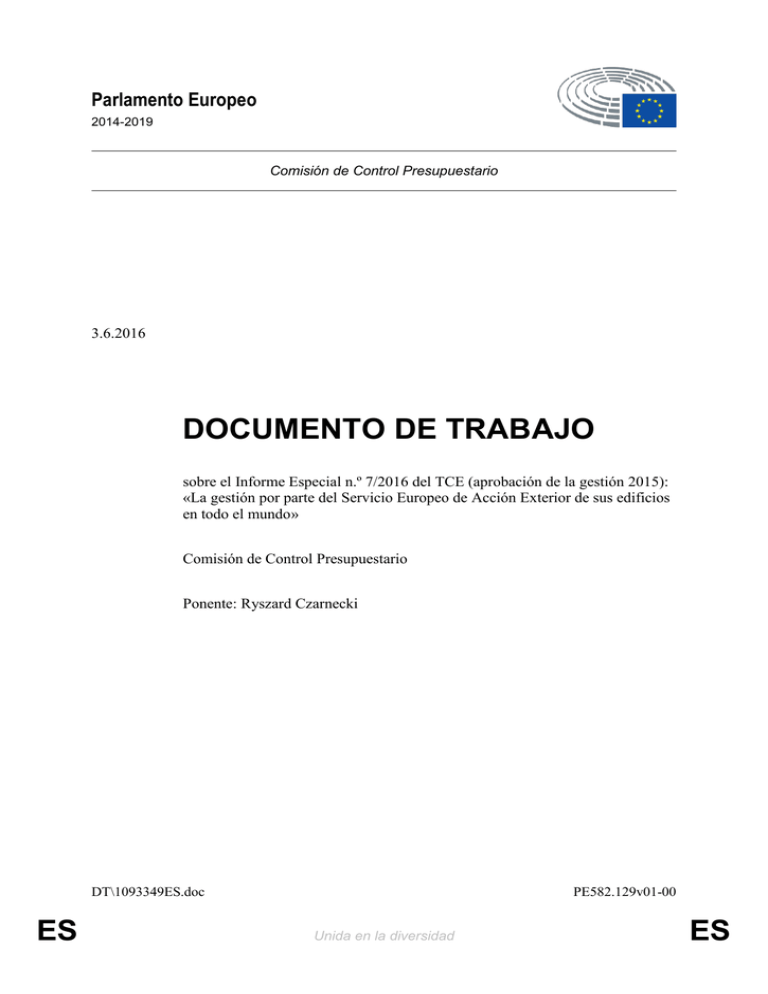
Parlamento Europeo 2014-2019 Comisión de Control Presupuestario 3.6.2016 DOCUMENTO DE TRABAJO sobre el Informe Especial n.º 7/2016 del TCE (aprobación de la gestión 2015): «La gestión por parte del Servicio Europeo de Acción Exterior de sus edificios en todo el mundo» Comisión de Control Presupuestario Ponente: Ryszard Czarnecki DT\1093349ES.doc ES PE582.129v01-00 Unida en la diversidad ES Introduction On its creation in January 2011, the European External Action Service (EEAS) took over responsibility for running EU delegations around the world from the European Commission. It provides office space for 5300 staff in around 140 delegations. The EEAS is also responsible for the residences of heads of delegation and for providing, or reimbursing the costs of, accommodation for 2400 staff. The effective management of EU delegation buildings contributes to achieving the EU’s objectives in foreign policy, trade and development cooperation. Delegation offices aim to provide a stable, visible, functional and secure working and meeting environment for staff and visitors. Buildings should provide value for money, and sharing office premises with Member States or other EU institutions and bodies is actively promoted. Some 80 % of delegation office buildings and residences of heads of delegation are rented, the rest are owned. EEAS expenditure on delegation buildings in 2014 amounted to 165 million euro. Audit Scope and approach The overall audit objective was to examine whether the EEAS manages delegation buildings well and the audit addressed the following sub-questions: a) Do delegation buildings meet the needs of the EEAS and provide value for money? b) Does the EEAS have effective procedures for selecting the right buildings? c) Does the EEAS have effective systems for monitoring the continued suitability of buildings and planning necessary changes? The Court based its audit work on four main sources: (i) a survey sent to 133 delegations, (ii) a review of a sample of 30 building files submitted by the delegations to Headquarter in 2013 and 2014, (iii) visits of four delegations (Nepal, Tanzania, Turkey and United States Washington DC) to examine building-management practices1 and (iv) the review of documentation related to policies, procedures and tools as well as quantitative information on delegation buildings. Court's Findings and Observations - Do delegation buildings meet the needs of the EEAS and provide value for money? The Court found that delegation buildings, whether office buildings, residences of heads of delegation or staff accommodation, generally meet the needs of delegations i.e. to ensure security, functionality, stability, visibility and best value for money2. 1 During the visits to the delegations, the Court also met heads of administration of Member States' embassies to discuss building-management practises (Belgium, Denmark, Finland, Germany, the Netherlands, Sweden and United Kingdom) and visited the Ministry of Foreign Affairs in the Netherlands to obtain further information on innovative policies for managing embassy buildings. 2 These objectives are classified by order of importance i.e. reflecting the highest weighting given by respondents to the survey. Other factors were also mentioned such as flexibility, environmental impact and PE582.129v01-00 ES 2/7 DT\1093349ES.doc However, in some cases, buildings do not provide best value for money for the following reasons: a) space in most office buildings, and some residences, exceeds the ceilings defined in the building policy according to which delegation offices should have a maximum size of 35 m2 per person. The Court observed that for 85 delegations in 2014, the average space per person was 41 m2. It was also found that 34 residences (or 24%) exceeded the maximum ceiling of 600m2 as stated in the EEAS building policy; b) the EEAS owns buildings which it no longer uses. The Court identified that the EEAS no longer uses 20% of the delegation buildings it owns (7 out of 33 office buildings and 6 out of 30 residences) but has retained them and for some of them unoccupied since 2004 (Botswana and Gambia), since 2012 (South Africa and Cape Verde), the exresidence of the head of delegation and a staff house in Tanzania unoccupied since 2009 with a cost of 25000 euro per year for security utilities and gardening; c) where delegations share their office premises with EU Member States1 or EU institutions or bodies for ensuring better visibility of the EU, facilitating cooperation with Member States and saving costs, some charges to hosted organisations do not recover full costs. The Court analysis showed that there were different ways for calculating charges to co-locating organisations, some of them do not recover full costs. The Court found that in Washington DC only the two most recent agreements out of five with different organisations were including a contribution to administrative overheads, no contribution to offices rent in Nepal (amounting 8000 euro per year) have been found or to charge when renting to other organisations in all new agreements for the use of common areas according to the 2013 guidance to delegations. - Does the EEAS have effective procedures for selecting the right buildings? The Court's examination showed that there is a structured procedure for selecting delegation buildings but there are some weaknesses at each of the major stages when it is applied in practice. The suitability of delegation buildings depends firstly on their initial selection and then on the way the EEAS ensures they continue to meet needs and provide value for money. The initial selection of buildings for rental or purchase is based on the building-file procedure. Before renting (or renewing a rental agreement) or buying, the delegation concerned submits a building file to headquarters for examination and approval2. In providing a structured and documented basis for decision-making, the building-file procedure is an example of good practice. However, there is a risk that the EEAS does not select the right buildings because there are some weaknesses in the practical application of each of the major stages of the selection procedure: accessibility for disabled people. 1 In 2015, 45 delegations were sharing their office premises with either EU Member States or EU institutions and bodies. The number of delegations hosting or hosted by Member States' embassies increased from 14 to 17 between May 2014 and May 2015. 2 The building file is necessary when the total value reaches 60000 euro or more, before any acquisition of land and when renting staff accommodation if the rent exceed the EEAS' ceiling for the country. DT\1093349ES.doc 3/7 PE582.129v01-00 ES a) when some delegations search the local market, they have insufficient expertise to identify suitable options and do not receive sufficient support from headquarters; b) when delegations present options to headquarters, the proposed solution is sometimes not based on a sound technical and financial analysis. The Court identified cases in which delegations do not produce building files for all new contracts (no building file for 230000 euro contract for Venezuela or 240000 euro contract for the residence in Nepal), where building files are unnecessarily detailed when delegations have no intention of moving, cases where delegations do not present options in a comparable way and files where the possibility of buying is rarely discussed (only five building files out of the thirty examined discussed the possibility of buying and none of the building files reviewed by the Court presented a comparison of renting with buying). The Court also noted that the guidance related to the preparation of building files does not explain how the space rented to Member states' embassies and other organisations and the income generated by co-location should be taken into account; c) when the Headquarters Building Committee makes its final decision, it is sometimes too late to sign a contract (for instance, although the building files for the residences in Israel and Sri Lanka were approved, contracts were not signed) and it does not always demonstrate that the decision represents best value for money. The Court showed that some decisions - seven out of 30 building files examined - did not contain a convincing reason for the building committee's decision. In four of these seven cases it was not demonstrated that the selected solution was in line with market rates and for the other three files, the amount of office space per person and the recommended ceilings in the building policy were not sufficiently considered (in Sri Lanka, Jordan and Washington DC). - Does the EEAS have effective systems for monitoring the continued suitability of buildings and planning necessary changes? The Court pointed out that the information on the suitability of buildings is not reliable and is not used for planning, which is too short term and particularly weak for owned properties. Once the EEAS has selected buildings, it regularly assesses whether they continue to meet the needs of delegations through site visits (namely through evaluations of delegations, health and safety inspections and security assessments), but it does not identify all shortfalls especially related to security issues. It was also found that the EEAS does not take into account all relevant factors when it monitors the space per person in office buildings nor does it monitor that rents of office buildings and residences remain in line with market rates and that charges to co-located organisations recover full costs. Furthermore, the Court stated that the EEAS does not reliably record the results of its monitoring in its information systems. If each delegation is responsible for encoding information related to its office buildings, residence and staff accommodation, the audit work revealed that 35% of office buildings and residences were not recorded in the information system 'Immogest' in 2014 and that the reliability of data of this system was not ensured. In addition, instead of using the system 'Immogest', the EEAS headquarters is using a central excel spreadsheet with the information on all delegation offices and residences and a separate inventory of owned properties but with incomplete or inaccurate data. PE582.129v01-00 ES 4/7 DT\1093349ES.doc The Court considered that this lack of reliable basic information on delegation buildings has a negative impact on the overall planning process by headquarters and its effectiveness. Moreover, the Court found that headquarters does not make effective use of the information available to draw up plans for taking corrective action and that the EEAS planning focuses on addressing short-term needs (i.e. around two years) without setting-up medium term priorities or options (i.e. to a 7-year horizon) in the management of delegations buildings. It is the long-term objective of the EEAS to purchase more delegation office premises as less than 20% of delegation office buildings and residences are currently owned. In 2015, under the new provisions in the financial regulation (article 203.8), the EEAS arranged terms for borrowing up to 200 million euro over four years to buy real estate. However, the Court observed that the EEAS has limited experience in owning buildings and lacks real-estate management expertise and has not established effective systems for buying, maintaining and selling buildings. Consequently, it has not established effective systems to manage owned properties, for example to maintain properties in good condition or to sell buildings which it no longer uses. Summary of the EEAS Replies The EEAS agreed that there are some shortcomings in its management of infrastructure in EU delegations and underlined the complexity and political sensitivity of managing 180 office buildings and 140 official residences in 138 countries throughout the world, each with its own specific legal system and property market. Given the acute, well-known budget constraints and the commitment on staff cuts, the EEAS reminded that this huge portfolio is managed by a headquarters team of only 13 staff backed by local administrative support at the level of delegations and stated that it has not been possible to accompany the significant expansion of the delegation network over recent years with a commensurate increase in the number of staff devoted to this task, which has been a management challenge. The EEAS also agreed that the existing tool for real-estate inventory management was in need of replacement, a new system will be fully implemented at the end of 2016 that will allow the EEAS to develop a more effective system for advance planning and programming of expenditure. Regarding the space in delegations’ buildings, the EEAS recalled that in 2013 the guidelines for maximum office space per person were reduced from 42 m² to 35 m² as a general rule, with the possibility of additional space for specific needs such as meeting rooms for meetings with Member States. These new guidelines apply for all new acquisitions, but the EEAS acknowledged that it will take some time for the average to come down towards the new target. In cases where delegations have spare capacity, co-location with Member State embassies or other EU bodies is actively sought. Regarding the owned buildings, there are indeed a number of properties that are owned by the EEAS that are no longer used, either because of the security environment or other local conditions. The relevant delegations have been asked to sell these properties, but this can be a lengthy and politically sensitive process. DT\1093349ES.doc 5/7 PE582.129v01-00 ES Court's recommendations The Court makes eight recommendations in order to fulfil the needs of delegations and to increase the value for money of the building policy: 1. Include environmental factors, access for disabled people and flexibility as objectives in the building policy for office buildings; 2. Ensure charges paid by other bodies hosted in Delegation buildings are consistent and recover full costs; 3. Strengthen the application of the procedure for selecting buildings; 4. Use a central source of information to verify and monitor market rental rates for office buildings; 5. Improve its real-estate management information system to provide more reliable and relevant information to feed into the planning process; 6. Reinforce expertise in real-estate management at Headquarters to develop a more strategic approach; 7. Establish medium-term priorities for rentals, purchases, sales, modifications and maintenance; 8. Introduce systems to manage owned buildings effectively. Recomendaciones del ponente para su posible inclusión en el informe anual de aprobación de la gestión de la Comisión [El Parlamento Europeo] 1. Acoge con satisfacción el informe especial dedicado a la gestión por parte del Servicio Europeo de Acción Exterior de sus edificios en todo el mundo, y expone a continuación sus observaciones y recomendaciones; 2. Hace hincapié en que el SEAE y los Estados miembros comparten el interés por seguir desarrollando la cooperación local en el ámbito de la gestión inmobiliaria, prestando una atención particular y continua a las cuestiones referentes a la seguridad, la rentabilidad económica y la imagen de la Unión 3. Se congratula del aumento de los proyectos de coubicación de las delegaciones de la Unión con los Estados miembros, mediante la firma de diecisiete memorandos de acuerdo; alienta al SEAE a que siga buscando la manera de ampliar estas buenas prácticas; considera que esta política debe incluir enfoques innovadores orientados a definir tanto una estrategia coordinada de coubicación con los Estados miembros deseosos de participar y unos acuerdos adecuados de costes compartidos en asuntos inmobiliarios y logísticos; 4. Deplora las deficiencias en el registro y las inexactitudes del sistema de información para la gestión de los edificios de oficinas y las residencias de las delegaciones; pide que se PE582.129v01-00 ES 6/7 DT\1093349ES.doc revisen periódicamente la exhaustividad y fiabilidad de los datos registrados por las delegaciones de la Unión; 5. Insta al SEAE que refuerce el control de su gestión y sus instrumentos de control de todos los costes derivados de la política inmobiliaria a fin de garantizar una visión global y un seguimiento exactos de todos los gastos; considera que debe hacerse hincapié en el respeto de los límites máximos definidos en la política inmobiliaria, a fin de reducir el alquiler anual total de las oficinas de las delegaciones, la adecuación de las contribuciones pagadas por las entidades en régimen de coubicación, la cobertura de los costes corrientes derivados de las situaciones de coubicación y la adecuación de los costes a las condiciones del mercado local; 6. Opina que deben desarrollarse rápidamente los conocimientos jurídicos y técnicos en materia de gestión inmobiliaria al tiempo que se considere cualquier opción alternativa rentable, como el recurso al asesoramiento externo, por ejemplo de operadores locales, para la prospección del mercado o la posible negociación con los propietarios; 7. Apoya la aplicación de una estrategia a medio-largo plazo que identifique todas las opciones, desde las prioridades de inversión o las posibilidades de adquisiciones, y la renovación de contratos de arrendamiento, hasta el compartir dependencias con los Estados miembros, teniendo en cuenta asimismo las previsiones de personal y la planificación y el desarrollo de políticas. DT\1093349ES.doc 7/7 PE582.129v01-00 ES

